| |
Transit of Venus
"Transit of Venus R.A Proctor 1875 New York
Brian Greig Collection"

The French, Dutch, English, Germans and Americans took part
in the Southern Hemisphere observations. The Germans went to the
Auckland Islands one of the worst locations possible. The Islands are
better known for the wreck of the General Grant and loss of gold bullion.
Castaway on the Auckland Isles "Captain
Thomas Musgrave 1866"
 top
top
Observations carried out by the German
transit party in the Auckland Islands
Brian Greig Collection

Observatory at Campbell Island for the transit of Venus
Passage de Venus mission de isle Campbell
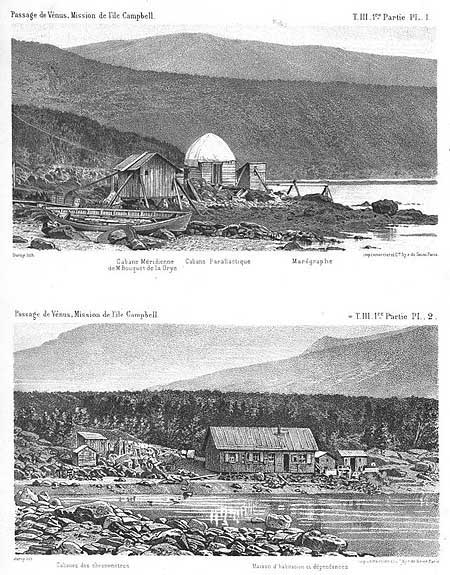
|
La France avait forme six
missions, distrubuees par moitie sur chaque hemisphere, et places
a Nagasaki, Pekin, a Saigon, a Noumea, "Nouvelle Caledonie",
de isle Saint Paul et a isle Campbell { Grand Ocean Meridional }.
Le chefs des missions francaises etainent MM..Jules Janeseen { Le
revolver photographique 1873. }, Fleuriais, Heraud, Andre, Admiral
Mouchez
{ Carte du Ciel } et Bouquet de la Grye.
France sent 6 expeditions spread
over each hemisphere Japan, China, Vietnam, New Caledonia the Island
of Saint Paul and Campbell Island in the Great Southern Ocean Jules
Janssen was a expert researcher into the composition of te sun,
in 1868 he and J.Norman Lockyer were instrumental in finding helium
in the solar prominence's around the sun.
Janssen went on to developed a
circular photographic plate which could take up to 60 pictures of
the suns limb about every second, one after another, a small clockwork
mechanism drove the plate around. When T.A.Edison meet Janssen it
inspired Edison in the development of moving pictures......"marque
aussi une etape dans les progres techniques ayant conduit a L'invention
du cinematographe"
|
|
|
While Admiral Mouche was perhaps better known for the "Carte
du Ciel" a ambitious project to photograph the entire sky { apart
from the extreme polar regions. } using observatories around the globe
. Melbourne and Sydney Observatories became involved at great cost
to their other work. Even today not all the results have been worked
out. Both men were at one time presidents of SOCIETE ASTRONOMIQUE
DE FRANCE founded by Camille Flammarion. in the 19th Cent.
Recueil de memories. Rapport et
documents relatifs a L'observation du Passage de Venus sur le Soleil
du Decembre 1874. "Academie des Sciences 1885"
|
 top top
Airy Transit of Venus Simulator
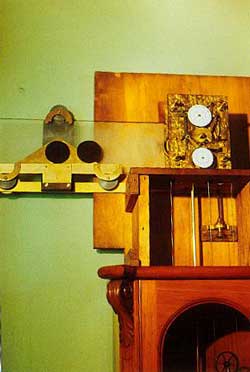
Brian
Greig Collection |
Sir George Biddle Airy made a mechanical
simulator for showing the "black drop" effect, see antique
sketch known as the Transit of Venus Model. Observers looked through
a telescope at the model and practiced with the model planet venus
on the limb of the sun. The simulator was driven by a long case
astronomical regulator.
Some observers spent 6 months getting in some practice
before leaving for their viewing sites around the world and being
faced with les phenomena de "guotte noir"
H.C.Russell Director of Sydney Observatory, Australia made his own
version of the black drop effect simulator. R.L.J.Ellery also used
a model venus at Melbourne Observatory adjacent to the Royal Botanic
Gardens.
Orrerymaker has made a working copy which will be driven by an electric motor, for
enquiries visit the above site. You have to supply the telescope.
|

Brian Greig Collection - English Mechanic 1873
|

A keen observer using a Herschelian reflecting telescope
keeping in touch via telegraph
with the English Transit party led by Palmer, near Christchurch, New Zealand.
"The Graphic" March 20 1875 London - Brian
Greig Collection
Note the 6 inch refractor inside the
hut of these were assembled in the grounds of Greenwhich Observatory
for testing and assembly. See also the hut with the lady inside used at
Burnham, near Christchurch
New Zealand. Perhaps it's the one in the image to the right hand side
that was tested in Greenwich
Prefabricated huts were designed for
the 5 main English Transit of Venus expeditions to Egypt,
Sandwich Islands { Honolulu }. Rodriguez, Christchurch New Zealand under
the
command of Major H. Palmer, R.E. and Kerguelen Island Rev.Stephen J.Perry.
Science Museum picture Library and National Maritime
Museum Greenwich
 top top
English compound for viewing the transit of venus and for
keeping the locals out! Note the
Royal Marines on guard. This was station"B" at Honolulu, the
other four main observing
locations around the globe were also identified in like
manner.
"The Illustrated London News" Jan 23
1875 - Brian Greig Collection
 top top
In side the transit hut with a Troughton and Simms transit
instrument about 3 ins in diameter and
focal length of 36-1/2 ins . Note the astronomical regulator number "1916"
made by Messrs E.Dent
and Co London in 1870 { it was wound every Sunday at noon} countingsidereal
seconds and
the chronometer on the bench to the right.
"Pioneers of Science" O.Lodge 1926
London - Brian Greig Collection
 top top
KERNOT AT THE DALLMEYER PHOTOHELIOGRAPH
DURING CONTACT OBSERVATIONS
The Australasian Sketcher" Dec 26 1874
- Brian Greig Collection
The Photoheliograph at Melbourne Observatory
|
A photoheliograph
is a telescopic camera for photographing the sun. It was invented
in the mid-19th century by Warren De La Rue, astronomer and pioneer
photographer. This example was one of several of an improved design
constructed by J.H. Dallmeyer of London in 1874. It cost the Colony
of Victoria £364, and was installed at Melbourne Observatory
in time to photograph the transit of Venus across the face of the
sun in 1874. Over the following decades, thousands of its solar images
on glass plates were sent to the Royal Observatory at Greenwich for
research on the sunspot cycle.
The instrument weighs about 470 kg, but can be dismantled
to facilitate transport. It was taken on solar eclipse expeditions
to Tasmania, Tonga and Goondiwindi. An alternative lower end on
the tube allowed the sun's corona to be photographed during the
total phase of the eclipses
|
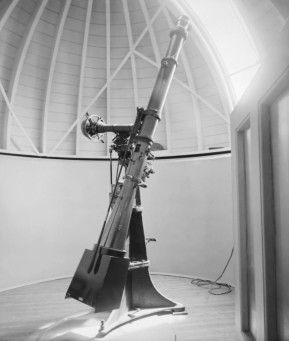 |
| © B.A.J. Clark
Australia 2004 |
| This Photoheliograph
was sold by public tender to an amateur astronomer after the Observatory
ceased professional astronomy in 1944. It continued in use at the
Observatory until it had to be removed in 1962 as a condition of the
sale. After 42 years of storage in suburban homes, it was re-installed
in its original dome by courtesy of the Director of the Royal Botanic
Gardens in Melbourne, in time for the June 2004 transit of Venus.
Unlike most of the other surviving Dallmeyer photoheliographs, it
has not been modernised. |

Robert Lewis John Ellery portrait painting from about
1900, some people believe he had a
medical qualification. This is just an old story that will not die. His
father and uncle were doctors
and he may have assisted in the surgery. He never signed any document
in his own hand apart from
C.M.G. F.R.S F.R.AS. and admitted to the Royal Society London he did not
mention in his application
{ as he was asked to do } any special qualifications which could have
included that of a
medical practitioner. Even his tombstone makes no mention of it.
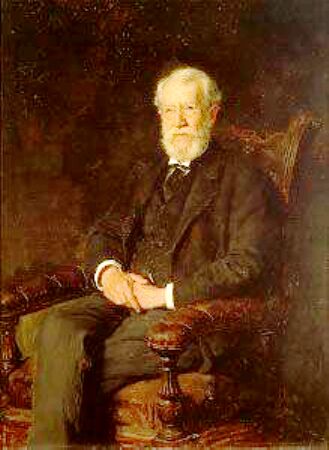
Image courtesy Wolfgang Steinicke Germany
 top top
18 inch Altazimuth Instrument { by Troughton and Simms of
London} used by
E.J.White in the North Equatorial Dome atop the Melbourne Observatory
{ or now known as the main building } for precise measurements of Venus
on the face of the Sun
Cyclopaedia Arts & Sciences C.Knight 1861 London
- Brian Greig Collection
Transit of Venus over Australia
Essays on Astronomy R.A.Proctor 1872 London -
Brian Greig Collection
 top top
 |
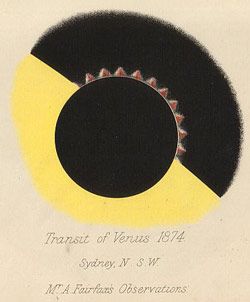 |
| Brian Greig Collection |
Observations of the Transit of
Venus H.C.Russell 1892 Sydney - Brian Greig Collection |
 top top
Sydney Observatory three years before
the 1874 Transit of Venus. The Director of the
observatory, H.C.Russell produced the book "Observations of the Transit
of Venus
9th December 1874 it was finally published in 1892."
Town & Country Journal 1871 September 16
Victoria - Brian Greig Collection
 top
top
|
|

